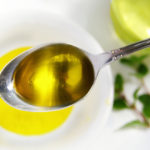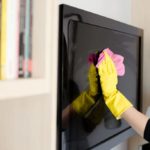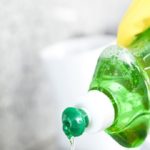According to research by the Global Hygiene Council, a cutting board can contain a group of E.coli bacteria that is 200 times higher than a toilet bowl. These bacteria can grow rapidly and be difficult to remove within 1 hour if the cutting board is not thoroughly cleaned.
To prevent this situation, you can apply some very simple methods using readily available products in the kitchen without incurring any cost. And the following article is what you can refer to!
Tips for cleaning cutting boards
1. Use white vinegar


How to do:
– Step 1: Rinse the cutting board with clean water and then use a cloth to dry the surface;
– Step 2: Pour 2 tablespoons of white vinegar onto the cutting board surface, then use your hand to evenly distribute the vinegar;
– Step 3: Sprinkle a moderate amount of salt on the cutting board surface;
– Step 4: Leave the cutting board like that for about 10 minutes to increase the effectiveness of disinfection;
– Step 5: Use dish soap to wash the cutting board and then dry it with a clean cloth.
Vinegar, being acidic, can soften dirt and disinfect well, while salt helps kill bacteria and increase friction on the surface of the cutting board.
2. Use toothpaste

How to do:
– Step 1: Rinse the cutting board with clean water and then use a cloth to dry the surface;
– Step 2: Apply a proper amount of toothpaste to the cutting board surface, then use a brush to scrub vigorously. At this point, you will see blackish residue coming off the cutting board surface, which is the dirt that needs to be removed;
– Step 3: Rinse the cutting board thoroughly with dish soap and clean water. Proceed to dry it as in step 1.
The abrasive ingredients in toothpaste will help kill bacteria and clean the cutting board.
3. Use cooking oil
This method should be done with baking soda.
Here’s how to do it:
– Step 1: Rinse both sides of the cutting board with water, damp dry with a cloth;
– Step 2: Apply a thin layer of cooking oil to all surfaces and edges of the cutting board;
– Step 3: Then, wrap the cutting board with plastic wrap for about 6 hours to allow the oil to fully penetrate the cutting board;
– Step 4: After 6 hours, remove the plastic wrap, wash the cutting board with baking soda and clean water. When the cutting board is clean, remember to dry it with a cloth.

Cooking oil is lighter than water, so it will create a protective film on the surface of the cutting board, isolating it from the air to prevent mold and inhibit bacterial growth.
Notes when using cutting boards to prevent infection
Here are some things you need to pay attention to:
– It is advisable to use cutting boards made of rubber or hard plastic to ensure hygiene;
– When using wooden cutting boards, it is necessary to regularly clean and disinfect them;
– Use mineral oil or beeswax to wipe the cutting board surface 2 – 3 times per month;
– Use different cutting boards for raw and cooked foods;
– Choose cutting boards of different colors to easily distinguish when using;
– Discard scratched or excessively dirty cutting boards.
Note when cleaning the cutting board:
– Avoid soaking wooden cutting boards in water as they are prone to damage and crack;
– It is recommended to thoroughly clean the cutting board after cutting food;
– Dry the cutting board after each cleaning to prevent mold;
– Different types of cutting boards will require different cleaning methods.
According to Vietnamese Women
Tips on Selecting Healthy Cooking Oil and Safe Ways to Cook with It
 Oil and Safe Ways to Cook with It’>
Oil and Safe Ways to Cook with It’>A Taiwanese company has made a significant impact on the food industry through the recycling of over 700 tons of dirty oil, which has been exported to over 12 countries, including Vietnam. This has raised a few eyebrows among housewives, as cooking oil is an essential condiment in daily cooking. To ensure the safety and quality of their cooking oil, consumers should take note of the following advice.


































